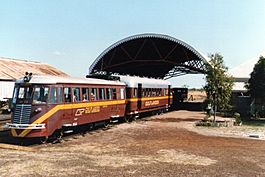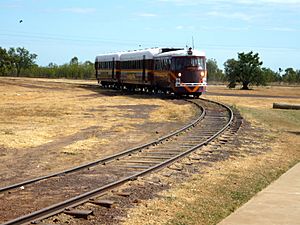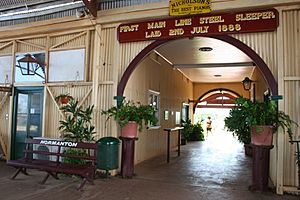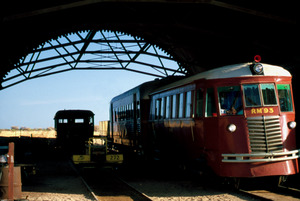Normanton to Croydon railway line facts for kids
Quick facts for kids Normanton to Croydon railway line |
|
|---|---|

RM93 and trailer on the Gulflander at Normanton, July 1991
|
|
| Overview | |
| Other name(s) | Normanton Railway |
| Owner | Queensland Rail |
| Termini | Normanton Croydon |
| Website | www.gulflander.com.au |
| Service | |
| Operator(s) | Queensland Rail |
| Depot(s) | Normanton |
| History | |
| Opened | 20 July 1891 |
| Technical | |
| Line length | 152 km (94 mi) |
| Track gauge | 1,067 mm (3 ft 6 in) |
| Operating speed | 40 km/h (25 mph) |
| Gulflander | |
|---|---|
| Lua error in Module:Location_map at line 420: attempt to index field 'wikibase' (a nil value). | |
| Location | Normanton to Croydon, Croydon, Shire of Croydon, Queensland, Australia |
| Design period | 1870s - 1890s (late 19th century) |
| Built | 1888 - 1891 |
| Official name: Normanton to Croydon Railway Line | |
| Type | state heritage (built, archaeological) |
| Designated | 21 October 1992 |
| Reference no. | 600396 |
| Significant period | 1880s-1970s (fabric) |
| Significant components | railway station, carriage shade (railway), railway, objects (movable) - transport - rail, crane / gantry, shed - shelter, tank stand, residential accommodation - workers' quarters, tank - water, machinery/plant/equipment - transport - rail, bridge/viaduct - railway, shed - goods, ramp |
The Normanton to Croydon railway line is a special train track in northern Queensland, Australia. It links the towns of Normanton and Croydon. This railway was built between 1888 and 1891. It is the last isolated railway line in Queensland that is still used today.
What makes this line unique is its clever design. It uses a special system of steel sleepers that can be covered by water during floods without getting damaged. This means the train can run again quickly after the water goes down. The buildings at the Normanton station are also very interesting. Today, the only train running on this line is the weekly Gulflander service. It uses a special railmotor and carriages.
This railway line was added to the Queensland Heritage Register on 21 October 1992. This means it's an important historical site.
Contents
History of the Gulflander Railway
In 1867, a man named William Landsborough explored the area around the Norman River. He was looking for a good port location for the cattle stations nearby. With him was George Phillips, who later surveyed the chosen port site of Normanton. Phillips then oversaw the building of the Normanton to Croydon Railway. He stayed interested in the area, even becoming a local politician in the 1890s.
Why Was the Railway Built?
People started talking about building a railway between Normanton and Cloncurry as early as 1883. The Queensland Parliament approved this idea in 1886. It was very hard to transport goods in this area. A train link would help the cattle stations and the Cloncurry Copper Mine. The plan was to eventually connect this new line to the main railway at Charters Towers. This would give access to the port of Townsville.
However, in November 1885, a huge discovery of gold happened near Normanton. By the end of 1886, about 2,000 people lived in the Croydon goldfield. This number grew to 6,000 the next year! Getting supplies to this goldfield became more important than the link to Cloncurry. So, the railway line was changed to go to Croydon instead.
A Clever Design for the Railway
The railway line used a very smart and new design because of the local land. The area was flat but hard for normal train tracks. This was due to floods, a lack of good wood for sleepers, and termite attacks. In 1884, George Phillips invented a system for building railways in such places. It used special U-shaped steel sleepers laid directly on the ground.
During floods, the line could be covered by water without washing away the gravel and dirt banks. This meant it could be used again quickly once the water went down. The steel sleepers also resisted termite attacks. Even though they cost more at first, they were cheaper to lay and maintain. The bridges along the line were also designed to go underwater safely. This system was perfect for the Gulf Country, and Phillips was in charge of building it.
Building the line had some challenges. It was hard to get enough of Phillips' special sleepers. They were made in Toowoomba and Glasgow. To keep building, some sections used wooden sleepers. Some bridges, meant to be steel, were also built with timber.
The construction involved clearing a three-metre wide path. This path was then prepared by removing tree stumps, ploughing, and rolling the ground. The U-shaped sleepers were then placed on this surface, and the rails were attached with special clips. The construction train would then pass over them, pushing the U-shaped sleepers into the ground. This made the rails sit just above the surface. Over time, the sleepers sank deeper into the ground.
Opening the Line
The first part of the line, 61 km from Normanton to Haydon, opened on 7 May 1889. The full route to Croydon opened on 20 July 1891.
The Normanton station had a large station building with a big arched roof to cover the carriages. It also had a goods shed. All these buildings were made of corrugated iron on wooden frames. Because the line was isolated, many workshops and maintenance buildings were added. Croydon had smaller sheds and a station with a roof over two tracks.
Most of the wooden sleepers on the line were soon replaced because of termite damage. However, one section over a salt pan kept wooden sleepers to prevent metal rust. Many low bridges were also part of this line. In 1900, two timber bridges were replaced with concrete and steel ones.
What the Railway Carried
At first, the train carried fresh food, mail, passengers, and goods like building materials. It also moved firewood for the mines. In the late 1890s, special trains ran for picnics at water holes. Weekend trips from Normanton to Croydon were also popular. The Golden Gate mine, near Croydon, was very busy from 1895 to 1901. The Golden Gate town had 1500 people. A weekend service between Croydon and Golden Gate started in 1902.
Changes Over Time
The goldfield at Croydon did not stay successful for long. By the early 1900s, gold production dropped a lot. After World War I, mining decreased, and it was clear the goldfield would not recover. The railway only made a profit between 1898 and 1902. Train traffic, which was never high, slowly went down.
The line stayed open as a community service. It was a very important link during the wet season. This was because Phillips' system worked well. The track could be used almost immediately after floods, while roads stayed blocked for much longer. The track also needed less maintenance than standard tracks. In the early 1920s, fewer staff were needed to save money.
To cut costs, and because getting enough water for steam trains was always a problem, the first railmotor was introduced in 1922. By 1929, steam locomotives were no longer used. In the 1930s, new all-weather roads made the railway less important. But until the late 1960s, the train remained a vital way to travel and transport goods. By 1974, the line was at risk of closing.
Since then, the line has mostly become a tourist attraction. In 1982, a railmotor was fixed up and named the "Gulflander". It makes a weekly trip to Croydon and returns the next day. Shorter special trips are also offered on other days. The train stops at places like Clarina, Glenore, Haydon, East Haydon, and Blackbull. There is often a photo stop at the old Golden Gate mine.
Not all the original buildings are still there. The Croydon station was destroyed by a storm in 1969. A new station building, similar to the original, was built in 2005. While other isolated Queensland railway lines were connected over time, the Normanton to Croydon line remained separate. The closest part of the Queensland Rail network is 190 km away.
What You Can See on the Railway Line
The Normanton to Croydon railway line stretches 94 miles (152 km) from Normanton to Croydon. It runs over flat land and crosses several streams using low bridges. The line mostly sits on Phillips' special steel sleepers. There are stations at each end and several stopping points in between.
Normanton Railway Station
The buildings at Normanton railway station are at the edge of town. They stand out clearly against the flat land. The main buildings include the station building with its large roof covering the carriages, the goods shed, a water tank, and a vertical boiler.
The station building is a rectangle with offices and a central hallway. It's made of corrugated iron over a wooden frame. The way the frame is built creates a cool pattern. The roof is also corrugated iron. A huge steel-framed roof, called a carriage shade, extends from the platform. It covers three tracks and has decorative cast iron columns made by the same company that supplied some of the steel sleepers.
The goods shed is a large building across from the station. It's also covered and roofed with corrugated iron. It has an inside loading platform and an outside one with a large crane from about 1902. The water tank is near where the engine shed used to be. It sits on a cast iron stand. You can also see the foundations of old workshops. A vertical boiler from A. Overend & Co is still there. There's a modern engine shed that holds the rail motor. You can also find parts of old trains and tracks scattered around the yards.
Blackbull and Croydon Stations
The station at Blackbull has a shelter shed built in 1966. It uses the same corrugated iron and timber frame style as older buildings on the line. An information center is set up in the old railway workers' living quarters. These buildings also have corrugated iron walls and special steel shutters. There's an old cast iron water tank from 1890 next to a water bore.
Croydon railway station is a simple building with corrugated iron walls and a low roof. It doesn't look like the original station that was destroyed. You can see old weighing scales outside. There's also a cylindrical water tank and a very old lever from 1887, which is quite rare.
The Croydon station also has living quarters similar to Blackbull's. It keeps some original equipment, like a crane, just like at Normanton. You can see the concrete base of the old goods shed. A loading ramp made of metal sleepers and rails is also still there, though it's in ruins. Parts of old locomotives are scattered around the yards.
Trains and Equipment
Because the railway line was isolated, old trains and equipment were often left at Normanton station instead of being thrown away.
- A10 class locomotives 202, 203 and 204. Locomotives 202 and 204 are on display at the Croydon Information Centre. Locomotive 203 is stored in Croydon in pieces.
- B12 class locomotive 28. You can see this train at Normanton Station.
- B13 class locomotives 161 and 234. These are also on display at Normanton Station.
- Panhard-Levassor petrol railmotor RM14. This is on display at the Ipswich Workshops Museum.
- AEC petrol railmotor RM31. This one was scrapped.
- AEC petrol railmotor RM32. This is on display at Normanton Railway Station.
- AEC petrol railmotor RM60. This one is still working at Normanton.
- AEC petrol railmotor RM74. This was changed to run on diesel and is on display at Redlands City Museum.
- QGR Diesel railmotor RM93. This train is still working at Normanton.
- Walkers Diesel Locomotive DL4. This locomotive is also working at Normanton.
Why This Railway is Important
The Normanton to Croydon Railway Line was added to the Queensland Heritage Register because it meets several important rules.
A Look into Queensland's Past
This railway shows how train systems in Queensland grew. They often started as separate lines connecting ports to resources inland. It also shows how important goldfields like Croydon could be, even if only for a short time.
A Rare and Special Railway
Most independent railways in Queensland eventually joined up. But the Normanton to Croydon line remained separate. It is the last isolated part of the Queensland Railways still in use. It's also the only complete line built using the special Phillips sleeper system that still works today. This system has worked well for over a hundred years with little maintenance.
Learning from the Past
Because this railway was so isolated, it needed its own workshops. Old trains and equipment were kept instead of being thrown away. This means the line still has many unique features. It can teach us a lot about how isolated railways were kept running and the technology they used.
Beautiful and Unique Design
The buildings along the railway show how people cleverly used local materials in a tough environment. The Normanton station, in particular, is a great example of railway architecture from the late 1800s in Queensland. In the flat, open landscape, its size and style make it a striking part of Normanton town.
Smart Engineering and Design
The railway line itself is a great example of clever engineering. It uses low-level tracks and bridges that can go underwater. The Phillips steel sleepers were an important invention for Queensland's conditions. This design has worked for over a hundred years, proving how good it was.
Connected to Important People
This railway is strongly linked to George Phillips. He helped explore the area, was a local politician, and designed and supervised the building of the railway. It's also connected to James Gartside, who designed the Normanton station buildings under Phillips' guidance.
Engineering Heritage Award
The Normanton to Croydon Railway Line received an Engineering Heritage Marker from Engineers Australia. This award recognizes its importance in engineering history.
Images for kids














